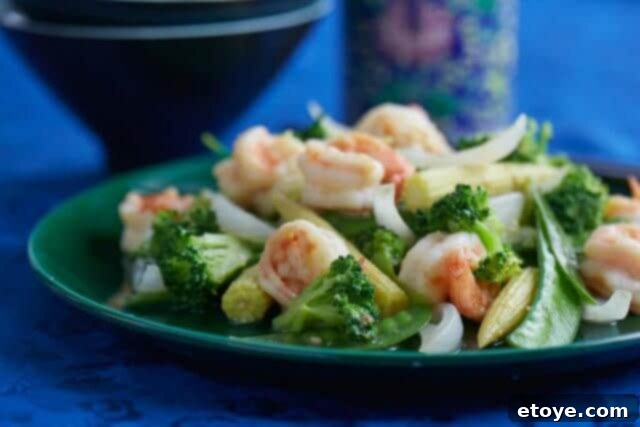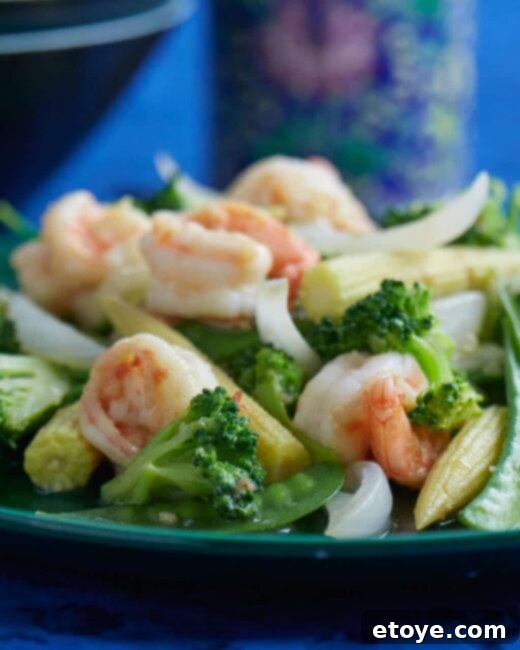
Jade Shrimp Recipe: Mastering the Art of Chinese Stir-Fry
Embark on a culinary journey to create the exquisite Jade Shrimp, a vibrant and flavorful dish that brings the magic of Chinese stir-fry right into your kitchen. This comprehensive guide will empower you to transform simple ingredients into a restaurant-quality meal, characterized by perfectly cooked shrimp, crisp vegetables, and a tantalizing sauce. Here’s what you’ll uncover:
- Expert techniques to ensure your vegetables remain crisp and brilliantly colored, while your shrimp achieve a succulent, juicy perfection.
- Practical tips for preventing garlic from turning bitter, a common pitfall in high-heat stir-frying.
- An authentic recipe adapted from the acclaimed “Everyday Chinese Cookbook” by television chef Katie Chin, bringing her mother’s legendary kitchen secrets to your home.
The Essence of Stir-Frying: Unveiling Restaurant Secrets
Stir-frying stands as one of the fastest and most dynamic cooking methods, renowned for its ability to produce incredibly fresh and flavorful dishes in minutes. However, many home cooks often find it challenging to replicate the steaming-hot, perfectly textured results found in their favorite Chinese restaurants. Have you ever encountered a stir-fry with undercooked vegetables, rubbery overcooked meat, or a dish that simply tasted muddled and lacked definition? The secret to successful stir-frying lies not just in speed—most stir-fries are completed in less than eight minutes from start to finish—but in two fundamental principles that ensure optimal flavor and texture for every ingredient. Let’s delve into these crucial elements:
Precision in Preparation: The Right Cut for the Right Cook
The foundation of an exceptional stir-fry begins long before the heat hits the wok: it starts with meticulous ingredient preparation, particularly the cutting. You’ll notice that ingredients in a professional stir-fry are consistently sized – small enough for a comfortable bite or two, yet not so tiny that they lose their integrity or require a knife. This consistency is paramount.
The principle is simple: the smaller and more uniform the cut of an ingredient, the faster and more evenly it will cook. For the rapid-fire nature of stir-frying, ingredients must be sliced, diced, or julienned to cook thoroughly within a brief timeframe. Meats, for instance, are typically cut into thin strips or bite-sized pieces to ensure quick searing and tenderness. Carrots are often julienned into slender matchsticks, onions are thinly sliced, and bell peppers are cut into manageable strips. This not only guarantees even cooking but also enhances the dish’s visual appeal and makes for a more enjoyable eating experience. Without precise cutting, some ingredients might be perfectly done while others remain raw or become mushy, leading to an inconsistent and unappealing texture.
The Art of Staged Cooking: Separate…and Then Together
While uniform cutting is vital, some ingredients naturally require more cooking time than others, even when properly prepped. Consider hearty vegetables like broccoli florets, which demand a bit more heat to reach their tender-crisp ideal. In this Jade Shrimp recipe, for example, the broccoli florets are blanched for about two minutes prior to being added to the stir-fry. This crucial pre-cooking step ensures that by the time the stir-frying is complete, you’re left with vibrant, perfectly cooked broccoli, rather than unpleasantly raw florets.
This brings us to the second, often overlooked, secret of traditional Chinese stir-frying: ingredients are frequently cooked separately, in stages, and then combined at the very end. This technique is a cornerstone for achieving superior results because it allows each component to cook optimally according to its specific needs. Delicate shrimp can be quickly seared without overcooking, while denser vegetables like broccoli or carrots can be softened to the perfect al dente texture. This method prevents overcrowding the wok, which would drastically lower the temperature and cause ingredients to steam rather than stir-fry, resulting in a bland, watery dish. By cooking ingredients in batches, you preserve their individual textures and flavors – your succulent shrimp will taste distinctly of shrimp, and your vibrant broccoli will retain its unique character, rather than becoming a garbled mish-mash of flavors. The Jade Shrimp recipe beautifully exemplifies both these essential stir-frying techniques, guiding you to culinary success.
Wok Hei and Heat Mastery: Elevating Your Stir-Fry
Beyond cutting and staging, true stir-fry mastery involves harnessing the power of heat and, ideally, achieving “wok hei” – the elusive “breath of the wok.” This unique smoky, charred aroma and flavor, a hallmark of authentic Cantonese stir-frying, comes from intense heat and rapid caramelization. While a home stove might not replicate a commercial burner’s power, you can approximate it by ensuring your wok or skillet is screaming hot before adding oil, and by not overcrowding it. Cook in small batches if necessary, allowing each ingredient to sear rather than steam. A properly seasoned wok, coupled with a high smoking point oil like grapeseed or peanut oil, will greatly contribute to the depth of flavor.
The Delicate Dance of Garlic and Ginger
Garlic and ginger are aromatic powerhouses in Chinese cuisine, but they require careful handling in a stir-fry. Adding them too early to high heat can cause them to burn and turn bitter, imparting an unpleasant taste to the entire dish. The key is to add them towards the middle or end of the stir-frying process, after other, harder vegetables have had a head start, or just before adding the main protein or sauce. A quick 30-second to 1-minute stir is usually sufficient to release their fragrant oils without burning. This ensures their bright, pungent notes enhance the dish beautifully, rather than detracting from it.
Chef Katie Chin and Everyday Chinese Cooking

Asian food expert, celebrated television chef, and accomplished author Katie Chin has recently delighted food enthusiasts with her new cookbook, “Everyday Chinese Cooking: 101 Delicious Recipes from My Mother’s Kitchen.” This beautifully crafted book is a tribute to the culinary legacy of her mother, the legendary and award-winning restaurateur, Leeann Chin. Katie Chin expertly translates the rich, authentic flavors of her family kitchen into accessible recipes that home cooks can confidently recreate.
We are particularly enamored with the book’s profound emphasis on comforting, homestyle dishes that evoke a sense of warmth and tradition. The recipes are not only incredibly delicious but also designed for practicality, making authentic Chinese cooking an everyday possibility. Among the many delectable offerings, we especially cherish dishes like:
- Stir-Fried Beef with Tomato: A savory and slightly tangy classic, perfect over steamed rice.
- Tangerine Beef: A fragrant and zesty dish, showcasing tender beef in a vibrant citrus sauce.
- Orange Chicken: A beloved takeout favorite, reinvented with fresh, balanced flavors.
- Wonton Soup: A light yet satisfying broth filled with delicate dumplings.
- Crispy Wonton: Irresistibly crunchy bites, ideal as an appetizer or snack.
- Shrimp Dumplings: Steamed parcels of tender shrimp, bursting with flavor.
- Chinese Chicken Salad: A refreshing and satisfying salad with a unique dressing.
- Baby Bok Choy: Simple yet elegant, highlighting the crisp-tender texture of this leafy green.
- Chow Fun: Wide, chewy rice noodles stir-fried with your choice of protein and vegetables, a true comfort food.
Katie Chin’s cookbook is an invaluable resource for anyone looking to explore the depth and diversity of Chinese cuisine with confidence and ease. Her recipes are a testament to her philosophy that delicious, authentic Asian food can be a joyful part of daily life.
You can purchase “Everyday Chinese Cooking Cookbook” on Amazon and begin your own journey into these delightful flavors.

The Jade Shrimp Recipe: A Culinary Gem
This Jade Shrimp recipe not only creates a delicious meal but also showcases the power of strategic cooking. The name “Jade Shrimp” perfectly captures the dish’s vibrant aesthetic, combining the delicate pink of perfectly cooked shrimp with the beautiful, verdant hues of broccoli and snow peas. This visually appealing dish is a testament to how simple ingredients, when handled correctly, can produce a sophisticated and satisfying experience. The careful blanching of the broccoli ensures its “jade” color and crisp-tender texture, while the rapid stir-frying of the shrimp locks in their natural sweetness and prevents them from becoming tough. The light, savory sauce brings all these elements together, coating each ingredient in a glossy, flavorful glaze that makes every bite a delight.
Enjoy this masterpiece over a bed of fluffy jasmine rice for a complete and wholesome meal. Its quick preparation time makes it an ideal choice for busy weeknights, yet its elegant presentation and exquisite flavors are impressive enough for entertaining guests. Feel free to experiment with other crisp vegetables like bell peppers or asparagus, or add a sprinkle of toasted cashews for extra crunch. The versatility of stir-frying allows for endless variations, making this Jade Shrimp recipe a fantastic foundation for your creative culinary endeavors.
Jade Shrimp Recipe
Cut your broccoli florets no larger than 1 1/2″ diameter. If your broccoli is larger, add a little more cooking time when steam/blanching the broccoli.
Ingredients
- 8 ounces shelled and deveined large-sized raw shrimp
- 2 teaspoons cornstarch, divided
- salt and dash of white pepper (or black pepper)
- 1/2 teaspoon Asian sesame oil
- 8 ounces broccoli florets
- 1 tablespoon soy sauce
- 1 tablespoon oyster sauce
- 1 tablespoon oil, divided
- 1 small white onion, thinly sliced
- 2 ounces snow peas, tips and strings removed
- 1 clove garlic, minced
- 4 tablespoons chicken stock, homemade (page 62) or store-bought
- 2 ounces canned baby corn, cut in half lengthwise
Instructions
- In a medium bowl, toss the shrimp with just 1 teaspoon of cornstarch, salt, pepper and sesame oil. Set aside to marinate.
- In the wok (or saute pan), boil 1 cups of water over medium-high heat. When water is boiling, add the broccoli florets, cover with lid and let steam/blanch for 1 minute, shaking the pan halfway through. The broccoli should be bright green, and still a little crisp. Drain and set aside. Wipe pan dry.
- In a small bowl, mix the remaining 1 teaspoon cornstarch, soy sauce and oyster sauce. Set aside.
- In the pan, and heat just 1 tablespoon of cooking oil over medium-high heat. Add the shrimp and stir-fry for 2 minutes, or until they turn pink. Remove from the pan and set aside.
- Wipe the wok or pan clean with paper towel, then heat the remaining 1 tablespoon oil over high heat. Add the onion and snow peas and stir-fry until fragrant, about 1 minute. Add in the garlic and stir fry for an additional 30 seconds.
- Pour in the chicken stock and heat to boiling, then stir in the cornstarch/soy/oyster sauce mixture and cook until the sauce thickens, about 30 seconds.
- Add the baby corn and stir-fry for 1 minute. Stir in the reserved shrimp and broccoli and cook, stirring constantly for 1 minute, until the shrimp are hot.
